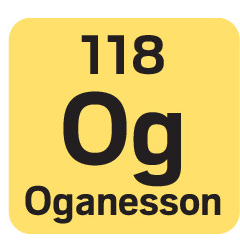
Last month, a junior high school student in New Jersey suggested that we feature “a known isotope of the last element of the periodic table”. Even though this would be an atom and not a molecule, we thought it would be of interest to our readers. We take “last element” to mean the element with the highest atomic number.
To date, the highest atomic number element to be discovered or synthesized is oganesson (symbol Og), with atomic number 118. This is something of a “magic” number because it completes the seventh row of the periodic table of elements. As such, it most likely has the imposing electron configuration 1s22s22p63s23p64s23d104p65s24d105p66s24f145d106p67s25f146d107p6. This composition has not been confirmed experimentally.
Oganesson is named after Russian nuclear physicist Yuri Oganessian, a leader of the Russian–American team that created most of the elements with atomic numbers >110. The team consists of scientists at the Joint Institute for Nuclear Research (Dubna, Russia) and Lawrence Livermore National Laboratory (CA).
The team’s first indication that it had produced element 118 came in 2002. They bombarded atoms of californium-249 with calcium-48 atoms to produce a few nuclei with atomic mass 294. The nuclear reaction was later established to be 249Cf + 48Ca → 294Og + 3n, where n stands for neutron. Additional experiments to confirm the existence of 249Og continued for the next decade. In 2015, the Joint Working Party of the International Union of Pure and Applied Chemistry and the International Union of Pure and Applied Physics recognized the discovery of oganesson. At that time, Oganessian and colleagues reported an 294Og half-life of 0.69 ms.
In 2011, researchers at the GSI Helmholtz Center for Heavy Ion Research (Darmstadt, Germany) reported the possible discovery of 295Og, but this finding has not been confirmed. Computer modeling shows that more stable isotopes of oganesson may have atomic masses as high as 313.
Oganesson-294’s extremely short half-life precludes measurements of its physical and chemical properties. Although the element is positioned in the noble gas column (group 18) of the periodic table, theorists believe that it probably is neither a gas nor “noble”—that is, unreactive.

Learn more about this molecule from CAS, the most authoritative and comprehensive source for chemical information.
Molecule of the Week needs your suggestions!
If your favorite molecule is not in our archive, please send us a message. The molecule can be notable for its current or historical importance or for any quirky reason. Thank you!
Stay Ahead of the Chemistry Curve
Learn how ACS can help you stay ahead in the world of chemistry.


